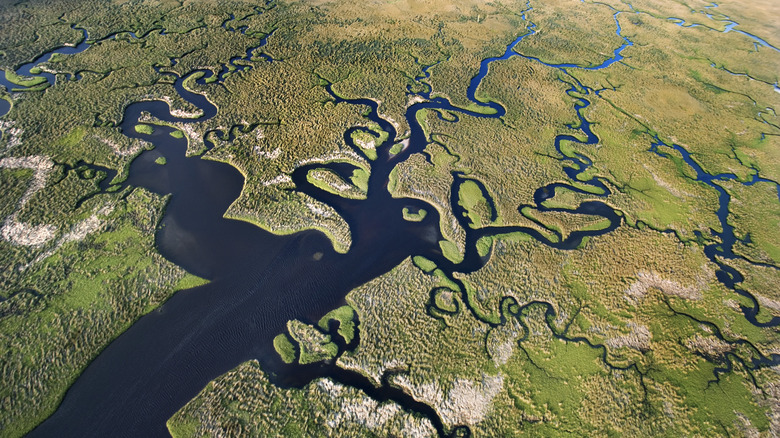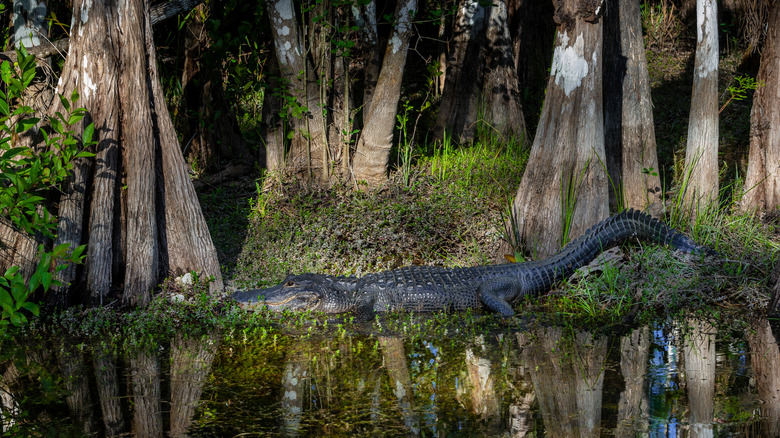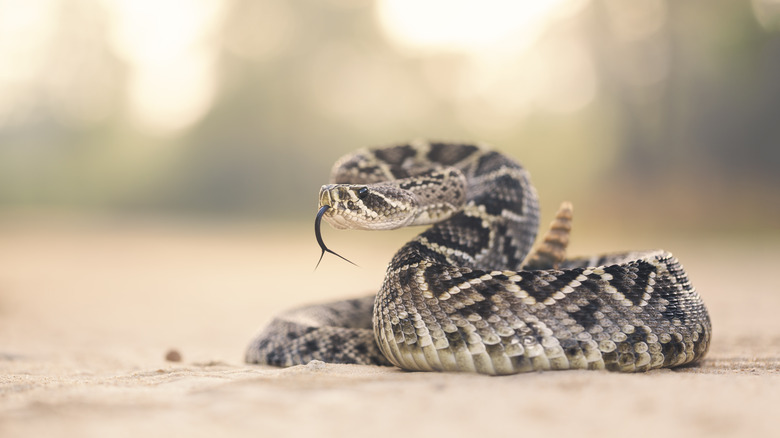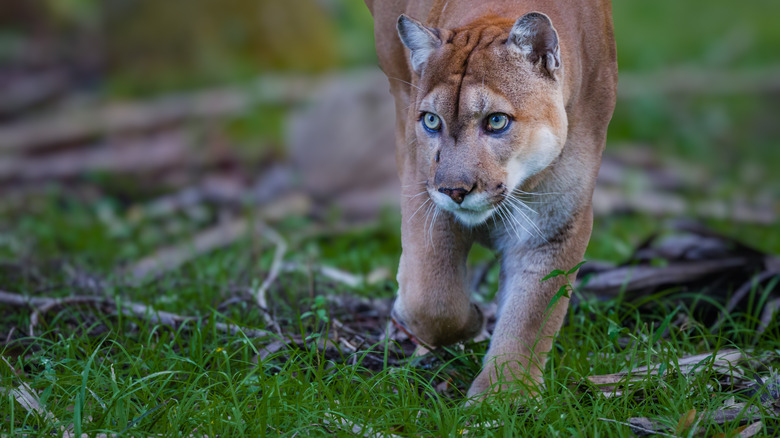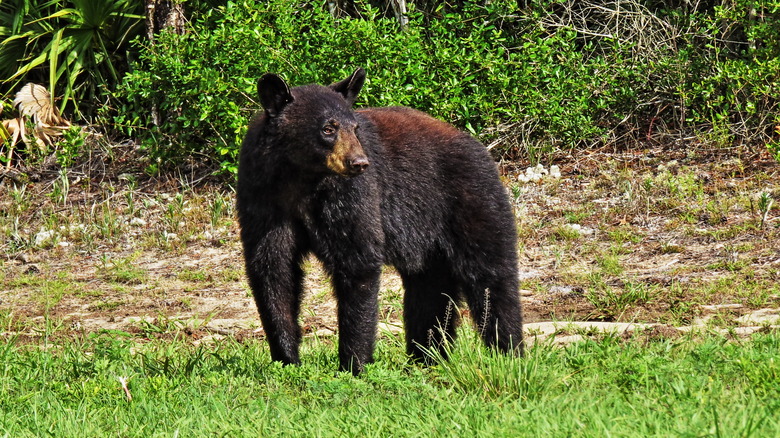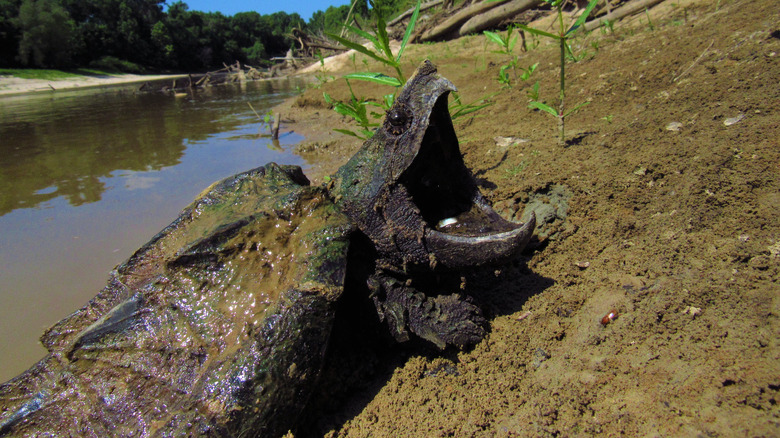5 Creatures To Beware Of When Adventuring In The Florida Everglades
The Florida Everglades is one of the largest wetlands in the world and contains a staggering amount of biodiversity. However, with high levels of biodiversity sometimes comes high levels of danger. In the Everglades, not only are the animals fearsome, but the water is filled with dangerous bacteria, and some of the plants are even out to get you (like saw grass) — all of which is why we ranked this area one of the most dangerous places to fish. While visiting the Everglades National Park is relatively safe compared to other national parks where people are injured during falls, the danger of the Everglades lies in its wildlife.
In fact, according to one of the park's public information officers in an interview with Our National Parks, "injuries result when visitors approach wildlife too closely or are intentionally provoking the animals and the animals respond in a defensive manner." While you probably already know that you need to be on the lookout for alligators and crocodiles while exploring the Everglades (as the park is the only place in the world where you can see both), there are plenty of other wild animals that you should be aware of during your time in this diverse ecosystem of South Florida.
Alligators and crocodiles
As the number one attraction for people who visit the Everglades, we had to put these two different species of ancient reptiles at the top of the list. Although alligators and crocodiles can be quite similar in appearance, crocodiles are typically larger and more aggressive making them the most dangerous of the two. However, while there are some crocodiles in the Everglades — an estimated 2,000 — you are more likely to encounter an alligator. Despite being less aggressive, alligators are much more common in the Everglades with over 200,000 individuals and are responsible for the most attacks.
Over the last decade, alligators were responsible for around eight attacks on humans in Florida each year that required medical attention, per the Florida Fish and Wildlife Conservation Commission, though the vast majority of those do not happen in the Everglades. While only around 4% of alligator attacks are fatal (via the University of Florida), many of these attacks result in the need for medical attention and can even loss of limbs.
So, what is the best way to avoid getting bitten by one of these impressive and fearsome creatures? By following all rules and guidelines posted in the Everglades by the National Park Service and maintaining a safe distance from the edge of any waterbodies. If you do see an alligator or crocodile, make sure to stay at least 15 feet away from it at all times and back away even further if it starts to hiss — then run if it charges.
Snakes
Unfortunately, alligators and crocodiles aren't the only sharp-tooth slithery reptiles you need to be on the lookout for while in the Everglades. Snakes are also a big problem and are one of the reasons that swimming is not recommended or allowed in the Florida Everglades. However, out of all the snakes that call the Everglades their home — including the invasive Burmese python — the most dangerous two are the cottonmouth (also known as a water moccasin) and eastern diamondback rattlesnake. We ranked these two as part of the 20 most dangerous snakes in the world for good reason.
The eastern diamondback is the largest rattlesnake in North America and is a great swimmer famous for its painful bite that can turn fatal in under two hours. While a bite from the eastern diamondback can kill you, luckily there is an anti-venom available at most hospitals if you get there in time. Cottonmouths are typically more shy than rattlesnakes and prefer to avoid people. However, these reptiles will still bite if they feel threatened. Although not every cottonmouth bite injects venom into its victim, if a snake does choose to use venom, you will have a one-hour window to get treatment.
The Florida panther
When imagining the animals that live in the Everglades, a big cat may not necessarily come to mind. However, the Everglades are indeed home to one very important (and endangered) big cat: the Florida panther. Although there are only around 120 to 230 of these cats left in the wild, they are still formidable and dangerous creatures with sharp claws and teeth that can weigh up to 160 pounds. And because these big cats are masters of stealth, you probably won't even know if there is one nearby.
While there are no recorded incidents of Florida panthers attacking and killing a human (via the U.S. Fish and Wildlife Service), if you are ever in the Everglades and see one you should still protect yourself by trying to appear larger and slowly backing away from the animal giving it plenty of space. In the unlikely event that a panther becomes aggressive, you should react to it in the same way that you would in an encounter with a mountain lion – which means back away slowly and try to make yourself look as large as possible. You can also report your panther sighting and experience to the Florida Fish and Wildlife Conservation Commission to help with their conservation efforts.
Black bears
Just like with the Florida panther, you may not have known that there is such a thing as the marsh-dwelling Florida black bear. Although this unique black bear lives in pockets across the Sunshine State, many of these bears live in and around the Everglades. While Florida black bears are typically quite shy, unlike the Florida panther, they have been known to attack humans under the right circumstances such as when trying to get food or defending their cubs. As reported by the Florida Fish and Wildlife Service, there have been 39 documented black bear attacks in Florida since 2006.
While previously considered endangered due to successful conservation efforts, the Florida black bear population is around 4,000 individuals. Weighing up to 350 pounds, these strong and clawed creatures are not something you want to run into in the wild. However, if you do, you should stand tall while backing away slowly. According to the Florida Fish and Wildlife Service, you should never run from a black bear, try to play dead or climb up a tree. The best course of action with a black bear is to make yourself look big and intimidating while getting to safety.
Alligator snapping turtles
The last animal on this list is another reptile with a mean bite — the alligator snapper. While these animals typically live on the bottom of murky waters in the Everglades and aren't known to seek out and attack people, they will become aggressive if disturbed and have a bite strong enough to break through bone. In fact, these nearly 200-pound reptiles have been known to bite off fingers and other extremities. It's because of this reason that researchers are very careful when handling them, and why it is recommended that you never approach or touch a snapping turtle while in the Everglades.
However, despite their powerful bite and spiky outer shell, humans are more dangerous to these turtles than they are to us. Overhunting and climate change have caused the population of this prickly turtle to plummet making the U.S. Fish and Wildlife Service propose that the reptiles be placed on the threatened species list. Because these turtles can take 21 years to reproduce, population recovery is a long and slow process.
